Immigrants from Peru vs Guamanian/Chamorro Community Comparison
COMPARE
Immigrants from Peru
Guamanian/Chamorro
Social Comparison
Social Comparison
Immigrants from Peru
Guamanians/Chamorros
5,294
SOCIAL INDEX
50.4/ 100
SOCIAL RATING
181st/ 347
SOCIAL RANK
4,082
SOCIAL INDEX
38.3/ 100
SOCIAL RATING
205th/ 347
SOCIAL RANK
Guamanian/Chamorro Integration in Immigrants from Peru Communities
The statistical analysis conducted on geographies consisting of 179,854,036 people shows a slight negative correlation between the proportion of Guamanians/Chamorros within Immigrant from Peru communities in the United States with a correlation coefficient (R) of -0.083. On average, for every 1% (one percent) increase in Immigrants from Peru within a typical geography, there is a decrease of 0.005% in Guamanians/Chamorros. To illustrate, in a geography comprising of 100,000 individuals, a rise of 1,000 Immigrants from Peru corresponds to a decrease of 4.6 Guamanians/Chamorros.
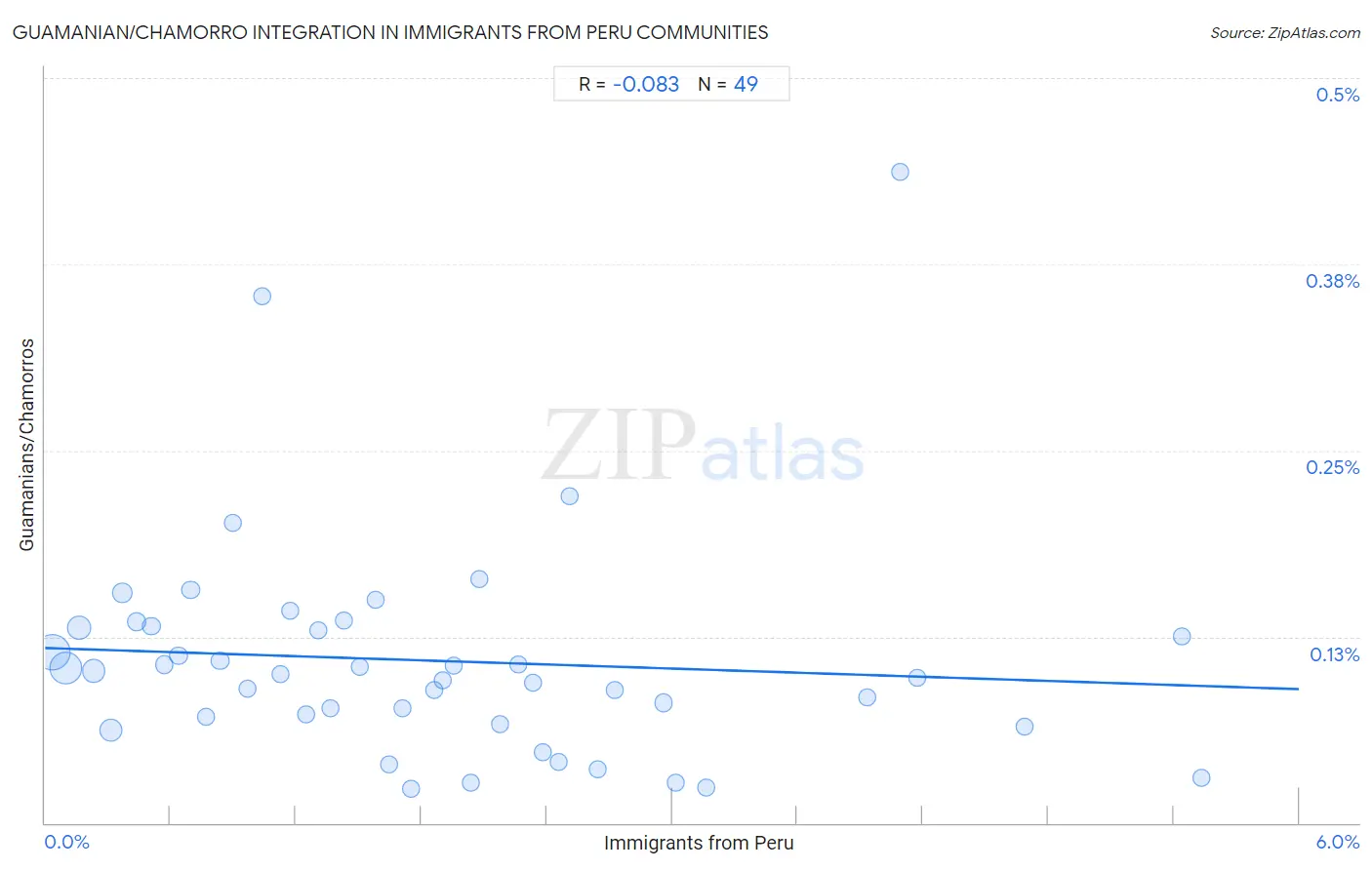
Immigrants from Peru vs Guamanian/Chamorro Income
When considering income, the most significant differences between Immigrants from Peru and Guamanian/Chamorro communities in the United States are seen in householder income under 25 years ($56,384 compared to $53,423, a difference of 5.5%), per capita income ($43,852 compared to $41,678, a difference of 5.2%), and householder income ages 25 - 44 years ($97,329 compared to $93,569, a difference of 4.0%). Conversely, both communities are more comparable in terms of median male earnings ($54,695 compared to $53,661, a difference of 1.9%), householder income over 65 years ($61,988 compared to $63,187, a difference of 1.9%), and householder income ages 45 - 64 years ($103,173 compared to $101,170, a difference of 2.0%).

| Income Metric | Immigrants from Peru | Guamanian/Chamorro |
| Per Capita Income | Average $43,852 | Tragic $41,678 |
| Median Family Income | Good $103,534 | Fair $101,061 |
| Median Household Income | Exceptional $89,010 | Good $86,255 |
| Median Earnings | Good $47,025 | Fair $45,933 |
| Median Male Earnings | Average $54,695 | Fair $53,661 |
| Median Female Earnings | Average $39,871 | Poor $38,717 |
| Householder Age | Under 25 years | Exceptional $56,384 | Exceptional $53,423 |
| Householder Age | 25 - 44 years | Excellent $97,329 | Fair $93,569 |
| Householder Age | 45 - 64 years | Excellent $103,173 | Good $101,170 |
| Householder Age | Over 65 years | Good $61,988 | Exceptional $63,187 |
| Wage/Income Gap | Excellent 25.1% | Fair 26.0% |
Immigrants from Peru vs Guamanian/Chamorro Poverty
When considering poverty, the most significant differences between Immigrants from Peru and Guamanian/Chamorro communities in the United States are seen in seniors poverty over the age of 75 (13.7% compared to 11.6%, a difference of 17.5%), seniors poverty over the age of 65 (12.0% compared to 10.5%, a difference of 14.5%), and female poverty among 18-24 year olds (16.9% compared to 19.0%, a difference of 12.8%). Conversely, both communities are more comparable in terms of family poverty (8.9% compared to 8.8%, a difference of 1.0%), single father poverty (15.3% compared to 15.1%, a difference of 1.6%), and female poverty (13.0% compared to 13.3%, a difference of 2.1%).
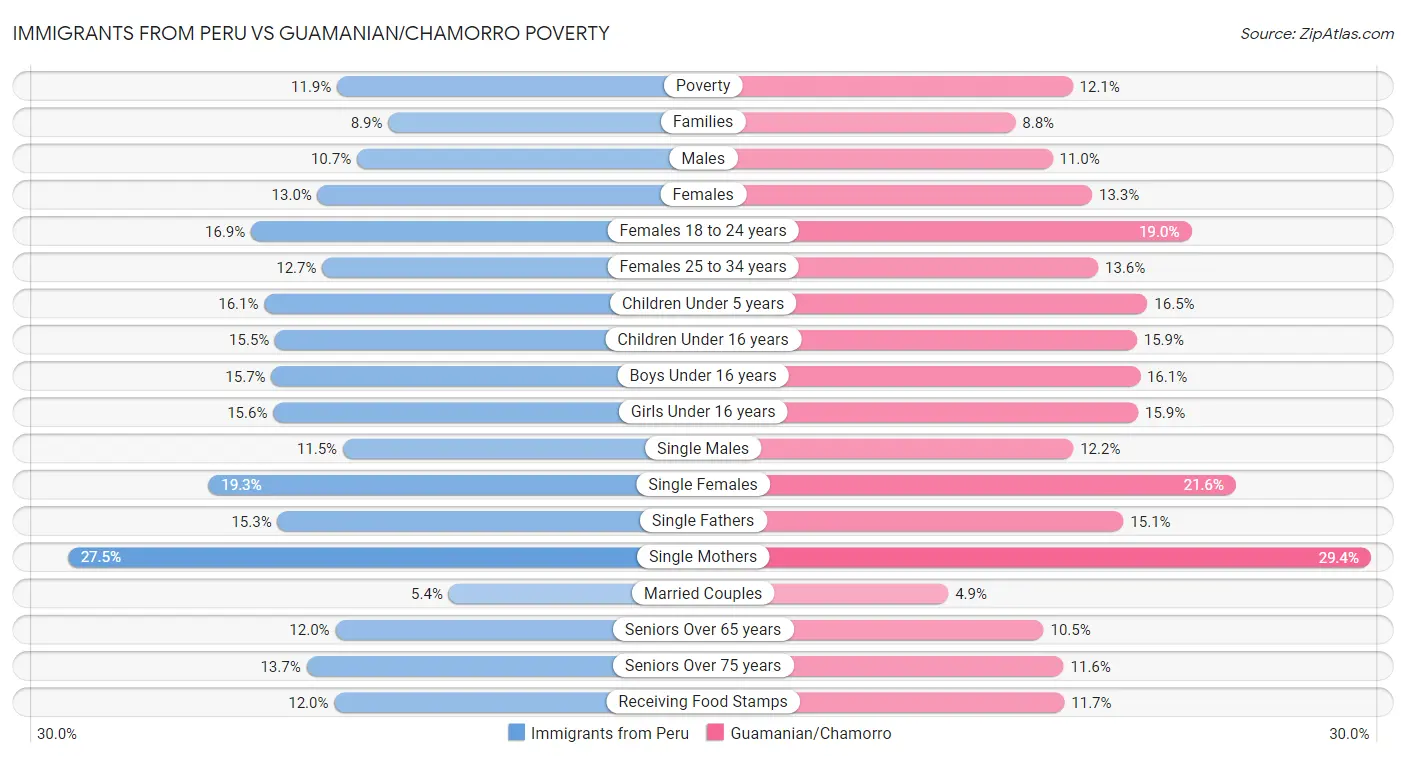
| Poverty Metric | Immigrants from Peru | Guamanian/Chamorro |
| Poverty | Excellent 11.9% | Good 12.1% |
| Families | Average 8.9% | Good 8.8% |
| Males | Excellent 10.7% | Good 11.0% |
| Females | Good 13.0% | Good 13.3% |
| Females 18 to 24 years | Exceptional 16.9% | Exceptional 19.0% |
| Females 25 to 34 years | Exceptional 12.7% | Average 13.6% |
| Children Under 5 years | Exceptional 16.1% | Excellent 16.5% |
| Children Under 16 years | Excellent 15.5% | Good 15.9% |
| Boys Under 16 years | Excellent 15.7% | Good 16.1% |
| Girls Under 16 years | Excellent 15.6% | Good 15.9% |
| Single Males | Exceptional 11.5% | Exceptional 12.2% |
| Single Females | Exceptional 19.3% | Poor 21.6% |
| Single Fathers | Exceptional 15.3% | Exceptional 15.1% |
| Single Mothers | Exceptional 27.5% | Fair 29.4% |
| Married Couples | Fair 5.4% | Excellent 4.9% |
| Seniors Over 65 years | Tragic 12.0% | Excellent 10.5% |
| Seniors Over 75 years | Tragic 13.7% | Exceptional 11.6% |
| Receiving Food Stamps | Fair 12.0% | Average 11.7% |
Immigrants from Peru vs Guamanian/Chamorro Unemployment
When considering unemployment, the most significant differences between Immigrants from Peru and Guamanian/Chamorro communities in the United States are seen in unemployment among ages 35 to 44 years (4.7% compared to 5.1%, a difference of 7.5%), unemployment among ages 30 to 34 years (5.5% compared to 5.8%, a difference of 5.4%), and unemployment among ages 25 to 29 years (6.5% compared to 6.8%, a difference of 4.0%). Conversely, both communities are more comparable in terms of unemployment among ages 20 to 24 years (10.4% compared to 10.4%, a difference of 0.65%), unemployment among youth under 25 years (11.8% compared to 11.9%, a difference of 0.88%), and unemployment among ages 55 to 59 years (4.8% compared to 4.9%, a difference of 0.89%).
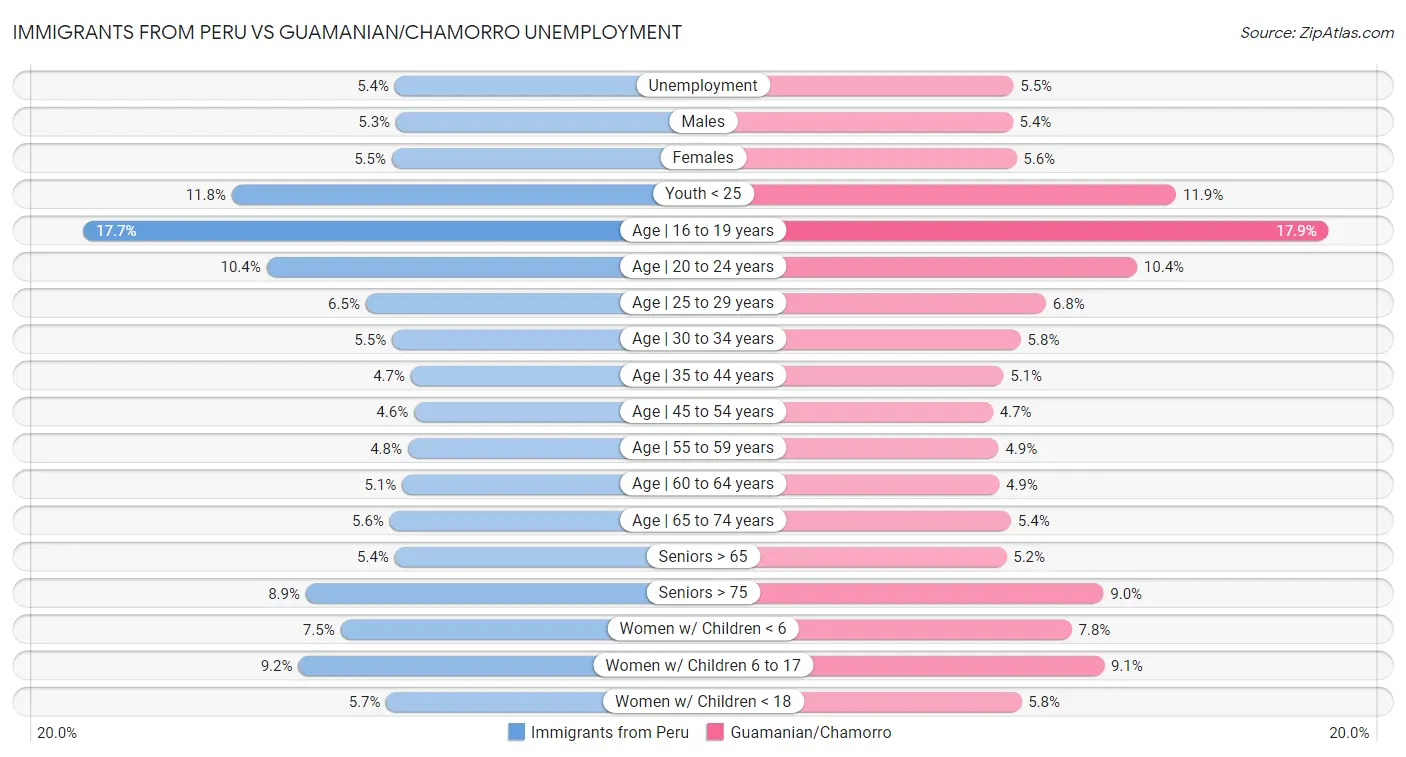
| Unemployment Metric | Immigrants from Peru | Guamanian/Chamorro |
| Unemployment | Fair 5.4% | Tragic 5.5% |
| Males | Average 5.3% | Poor 5.4% |
| Females | Tragic 5.5% | Tragic 5.6% |
| Youth < 25 | Poor 11.8% | Tragic 11.9% |
| Age | 16 to 19 years | Fair 17.7% | Poor 17.9% |
| Age | 20 to 24 years | Fair 10.4% | Fair 10.4% |
| Age | 25 to 29 years | Good 6.5% | Fair 6.8% |
| Age | 30 to 34 years | Average 5.5% | Tragic 5.8% |
| Age | 35 to 44 years | Fair 4.7% | Tragic 5.1% |
| Age | 45 to 54 years | Poor 4.6% | Tragic 4.7% |
| Age | 55 to 59 years | Fair 4.8% | Fair 4.9% |
| Age | 60 to 64 years | Tragic 5.1% | Fair 4.9% |
| Age | 65 to 74 years | Tragic 5.6% | Average 5.4% |
| Seniors > 65 | Tragic 5.4% | Fair 5.2% |
| Seniors > 75 | Fair 8.9% | Tragic 9.0% |
| Women w/ Children < 6 | Good 7.5% | Fair 7.8% |
| Women w/ Children 6 to 17 | Poor 9.2% | Fair 9.1% |
| Women w/ Children < 18 | Tragic 5.7% | Tragic 5.8% |
Immigrants from Peru vs Guamanian/Chamorro Labor Participation
When considering labor participation, the most significant differences between Immigrants from Peru and Guamanian/Chamorro communities in the United States are seen in in labor force | age 16-19 (34.2% compared to 38.2%, a difference of 11.9%), in labor force | age 20-24 (74.5% compared to 76.7%, a difference of 3.1%), and in labor force | age 45-54 (83.5% compared to 81.6%, a difference of 2.3%). Conversely, both communities are more comparable in terms of in labor force | age 25-29 (84.7% compared to 83.9%, a difference of 0.93%), in labor force | age > 16 (66.3% compared to 65.6%, a difference of 1.1%), and in labor force | age 30-34 (84.7% compared to 83.5%, a difference of 1.5%).

| Labor Participation Metric | Immigrants from Peru | Guamanian/Chamorro |
| In Labor Force | Age > 16 | Exceptional 66.3% | Exceptional 65.6% |
| In Labor Force | Age 20-64 | Exceptional 80.3% | Tragic 79.1% |
| In Labor Force | Age 16-19 | Tragic 34.2% | Exceptional 38.2% |
| In Labor Force | Age 20-24 | Poor 74.5% | Exceptional 76.7% |
| In Labor Force | Age 25-29 | Average 84.7% | Tragic 83.9% |
| In Labor Force | Age 30-34 | Average 84.7% | Tragic 83.5% |
| In Labor Force | Age 35-44 | Exceptional 84.9% | Tragic 83.4% |
| In Labor Force | Age 45-54 | Exceptional 83.5% | Tragic 81.6% |
Immigrants from Peru vs Guamanian/Chamorro Family Structure
When considering family structure, the most significant differences between Immigrants from Peru and Guamanian/Chamorro communities in the United States are seen in single father households (2.4% compared to 2.6%, a difference of 7.5%), family households with children (28.9% compared to 29.7%, a difference of 2.7%), and divorced or separated (12.0% compared to 12.3%, a difference of 2.0%). Conversely, both communities are more comparable in terms of single mother households (6.7% compared to 6.6%, a difference of 0.090%), births to unmarried women (31.8% compared to 31.6%, a difference of 0.59%), and average family size (3.31 compared to 3.29, a difference of 0.62%).

| Family Structure Metric | Immigrants from Peru | Guamanian/Chamorro |
| Family Households | Exceptional 67.2% | Exceptional 66.6% |
| Family Households with Children | Exceptional 28.9% | Exceptional 29.7% |
| Married-couple Households | Excellent 47.3% | Exceptional 48.1% |
| Average Family Size | Exceptional 3.31 | Exceptional 3.29 |
| Single Father Households | Poor 2.4% | Tragic 2.6% |
| Single Mother Households | Poor 6.7% | Poor 6.6% |
| Currently Married | Fair 46.4% | Good 47.1% |
| Divorced or Separated | Average 12.0% | Poor 12.3% |
| Births to Unmarried Women | Average 31.8% | Average 31.6% |
Immigrants from Peru vs Guamanian/Chamorro Vehicle Availability
When considering vehicle availability, the most significant differences between Immigrants from Peru and Guamanian/Chamorro communities in the United States are seen in no vehicles in household (11.5% compared to 8.0%, a difference of 43.9%), 4 or more vehicles in household (6.4% compared to 8.1%, a difference of 26.1%), and 3 or more vehicles in household (19.4% compared to 23.2%, a difference of 19.9%). Conversely, both communities are more comparable in terms of 1 or more vehicles in household (88.6% compared to 92.1%, a difference of 3.9%), 2 or more vehicles in household (54.4% compared to 60.5%, a difference of 11.2%), and 3 or more vehicles in household (19.4% compared to 23.2%, a difference of 19.9%).

| Vehicle Availability Metric | Immigrants from Peru | Guamanian/Chamorro |
| No Vehicles Available | Tragic 11.5% | Exceptional 8.0% |
| 1+ Vehicles Available | Tragic 88.6% | Exceptional 92.1% |
| 2+ Vehicles Available | Poor 54.4% | Exceptional 60.5% |
| 3+ Vehicles Available | Average 19.4% | Exceptional 23.2% |
| 4+ Vehicles Available | Average 6.4% | Exceptional 8.1% |
Immigrants from Peru vs Guamanian/Chamorro Education Level
When considering education level, the most significant differences between Immigrants from Peru and Guamanian/Chamorro communities in the United States are seen in no schooling completed (2.5% compared to 2.2%, a difference of 16.9%), professional degree (4.4% compared to 3.8%, a difference of 15.8%), and master's degree (14.9% compared to 13.1%, a difference of 13.9%). Conversely, both communities are more comparable in terms of nursery school (97.5% compared to 97.9%, a difference of 0.40%), kindergarten (97.5% compared to 97.9%, a difference of 0.41%), and 1st grade (97.4% compared to 97.8%, a difference of 0.41%).
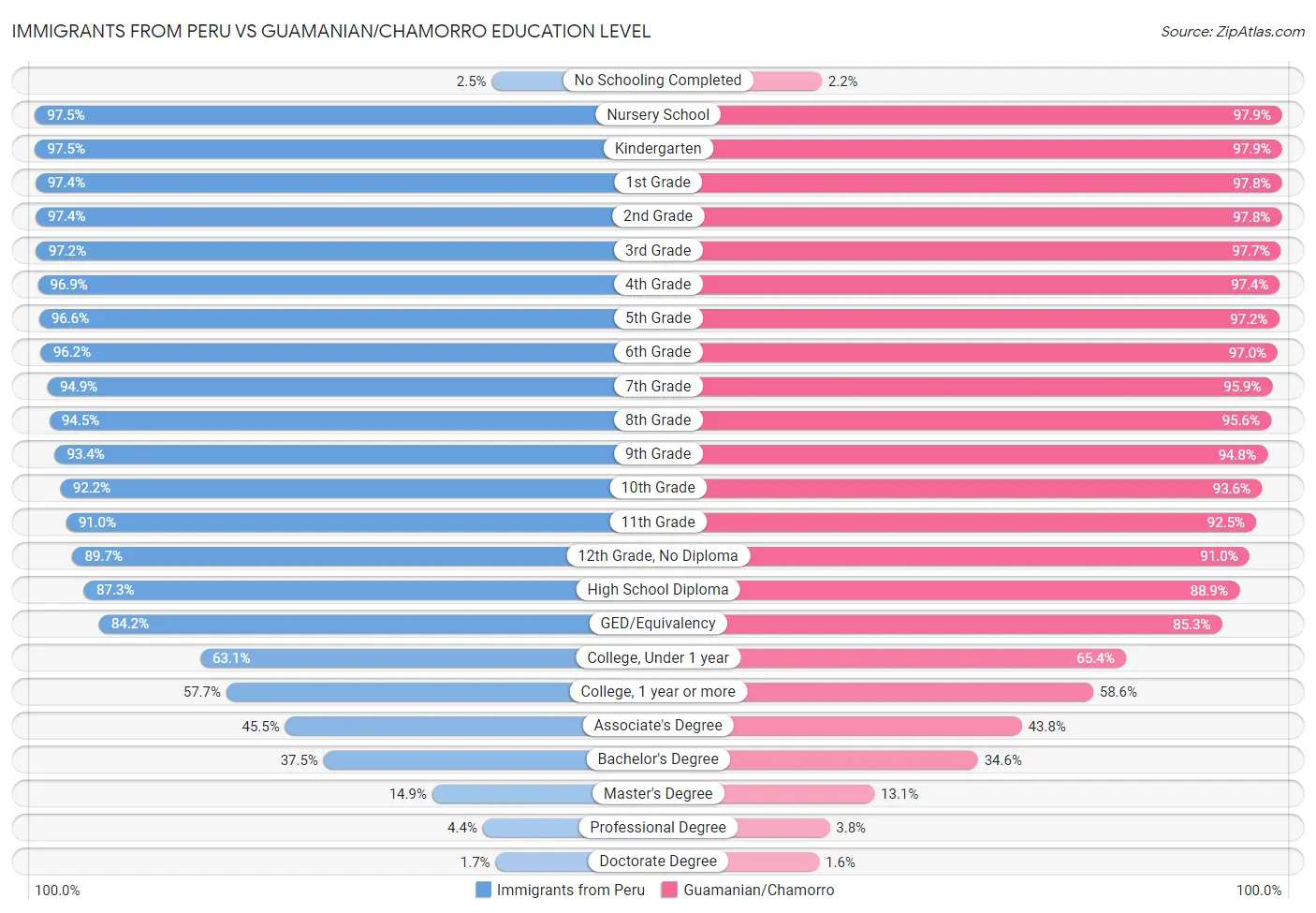
| Education Level Metric | Immigrants from Peru | Guamanian/Chamorro |
| No Schooling Completed | Tragic 2.5% | Fair 2.2% |
| Nursery School | Tragic 97.5% | Fair 97.9% |
| Kindergarten | Tragic 97.5% | Fair 97.9% |
| 1st Grade | Tragic 97.4% | Fair 97.8% |
| 2nd Grade | Tragic 97.4% | Fair 97.8% |
| 3rd Grade | Tragic 97.2% | Fair 97.7% |
| 4th Grade | Tragic 96.9% | Fair 97.4% |
| 5th Grade | Tragic 96.6% | Fair 97.2% |
| 6th Grade | Tragic 96.2% | Fair 97.0% |
| 7th Grade | Tragic 94.9% | Fair 95.9% |
| 8th Grade | Tragic 94.5% | Fair 95.6% |
| 9th Grade | Tragic 93.4% | Fair 94.8% |
| 10th Grade | Tragic 92.2% | Fair 93.6% |
| 11th Grade | Tragic 91.0% | Average 92.5% |
| 12th Grade, No Diploma | Tragic 89.7% | Fair 91.0% |
| High School Diploma | Tragic 87.3% | Fair 88.9% |
| GED/Equivalency | Tragic 84.2% | Fair 85.3% |
| College, Under 1 year | Tragic 63.1% | Average 65.4% |
| College, 1 year or more | Poor 57.7% | Fair 58.6% |
| Associate's Degree | Fair 45.5% | Tragic 43.8% |
| Bachelor's Degree | Average 37.5% | Tragic 34.6% |
| Master's Degree | Average 14.9% | Tragic 13.1% |
| Professional Degree | Average 4.4% | Tragic 3.8% |
| Doctorate Degree | Poor 1.7% | Tragic 1.6% |
Immigrants from Peru vs Guamanian/Chamorro Disability
When considering disability, the most significant differences between Immigrants from Peru and Guamanian/Chamorro communities in the United States are seen in disability age 35 to 64 (9.8% compared to 12.2%, a difference of 25.0%), disability age 18 to 34 (5.9% compared to 7.2%, a difference of 22.0%), and hearing disability (2.7% compared to 3.3%, a difference of 20.9%). Conversely, both communities are more comparable in terms of disability age under 5 (1.2% compared to 1.2%, a difference of 1.3%), disability age over 75 (46.9% compared to 49.4%, a difference of 5.3%), and self-care disability (2.4% compared to 2.6%, a difference of 6.4%).
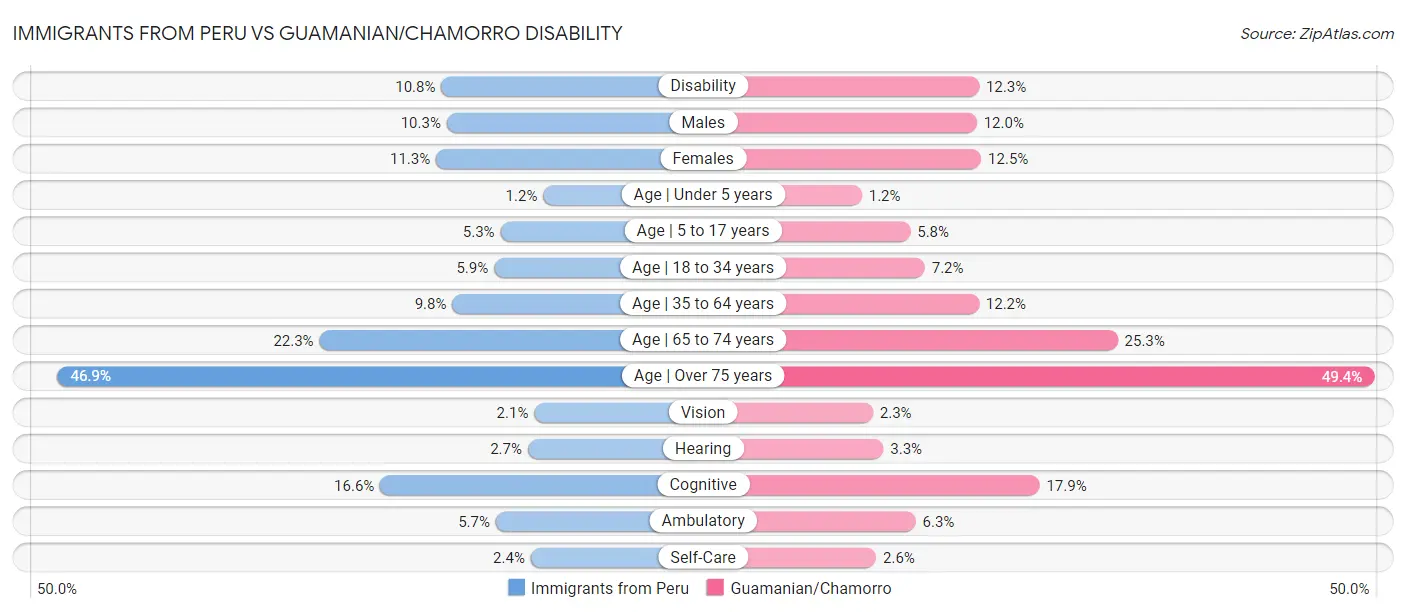
| Disability Metric | Immigrants from Peru | Guamanian/Chamorro |
| Disability | Exceptional 10.8% | Tragic 12.3% |
| Males | Exceptional 10.3% | Tragic 12.0% |
| Females | Exceptional 11.3% | Tragic 12.5% |
| Age | Under 5 years | Average 1.2% | Average 1.2% |
| Age | 5 to 17 years | Exceptional 5.3% | Tragic 5.8% |
| Age | 18 to 34 years | Exceptional 5.9% | Tragic 7.2% |
| Age | 35 to 64 years | Exceptional 9.8% | Tragic 12.2% |
| Age | 65 to 74 years | Exceptional 22.3% | Tragic 25.3% |
| Age | Over 75 years | Excellent 46.9% | Tragic 49.4% |
| Vision | Excellent 2.1% | Tragic 2.3% |
| Hearing | Exceptional 2.7% | Tragic 3.3% |
| Cognitive | Exceptional 16.6% | Tragic 17.9% |
| Ambulatory | Exceptional 5.7% | Poor 6.3% |
| Self-Care | Excellent 2.4% | Tragic 2.6% |